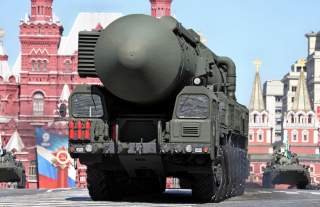Assessing an Iran Deal: 5 Big Lessons from History
"Negotiated agreements contributed significantly to the fact that we survived and, indeed, won the Cold War without nuclear Armageddon."
As the policy community prepares to assess an agreement between the U.S. and its P5+1 partners and Iran, Senate Foreign Relations Committee Chairman Bob Corker asked me to review the history of analogous agreements for lessons that illuminate the current challenge. In response to his assignment, I reviewed the seven decades of the nuclear era, during which the U.S. negotiated arms-control treaties, including the Non-Proliferation Treaty of 1968; strategic arms limitation talks and agreements from SALT to New Start; the North Korean accord of 1994; the agreements that helped eliminate nuclear weapons in Ukraine, Kazakhstan, and Belarus in the early 1990s; and the pact that eliminated the Libyan nuclear weapons program in 2003.
Among many lessons and clues from this instructive history, five stand out:
Lesson #1:
Arms control can advance American national interests without war. Negotiated agreements to constrain the spread and use of nuclear weapons have been an essential tool in the arsenal of American national security strategy. Such agreements are not an alternative to the use of military force, economic coercion, or covert action. Rather they are an instrument in the arsenal of American power that can be used in conjunction with other means to protect and defend our interests. Instructively, negotiated agreements contributed significantly to the fact that we survived and, indeed, won the Cold War without nuclear Armageddon.
Lesson #2:
No compromise, no deal. Because agreements are by definition negotiated – not imposed – they require give and take: compromise. As any parent or legislator knows well, the results of any negotiation invite a predictable litany of criticism: from mild remarks about painful concessions and remorse about the possibility of a better deal, to the extreme but still-common charges of “appeasement” or “conspiring with the enemy.”
Lesson #3:
Reduced risks. From the record of arms-control negotiations and agreements by both Republican and Democratic presidents – from Nixon and Reagan and both Bushes, to Kennedy, Johnson, Clinton, and Obama – one takeaway is hard to deny: agreements have reduced the risks of war, lowered the numbers of nuclear weapons, lessened uncertainties in estimating threats, and enhanced predictability.
Lesson #4:
North Korea is complicated. The case of North Korea is unquestionably a non-proliferation failure. The historical facts of the case, however, have been overtaken by legend. As we consider how policy failed, keep in mind these four questions:
- During the eight years in which North Korea was constrained by the nuclear agreement of 1994, how many nuclear weapons or weapons equivalent of fissile material did North Korea add to its arsenal, according to the best estimates of the U.S. intelligence community? Answer: none.
-From 2003 to 2008, when the U.S. confronted North Korea for cheating, abrogated the agreement, and sought to isolate and sanction Pyongyang, how many nuclear weapons or weapons equivalent of fissile material did it add to its arsenal? Answer: According to U.S. intelligence estimates, enough material for 2-to-9 more bombs.
-Under which treatment – agreements or confrontation – did North Korea conduct a nuclear weapons test? Answer: confrontation.
-Under which treatment – negotiations or confrontation – both in the Clinton–Bush and Obama periods did North Korea build its nuclear arsenal of more than a dozen weapons that it has today, according to U.S. intelligence estimates? Answer: confrontation.
Lesson #5:
Details matter. To paraphrase Shakespeare, in the realm of arms control, "deals are neither either good or bad in themselves, but details and context make them so.” Assessing the Iran deal – if there is one – depends vitally on both the fine print and the feasible alternatives. In foreign affairs, completely good deals are rare – and typically the result of massive military leverage after victory in war. The right standard, even for stakes as high as nuclear weapons, is good enough. In the case of Iran, good enough means a deal that does more than no deal and its feasible alternatives to prevent Iran from acquiring a bomb.
If Secretary Kerry and his team bring back an agreement that successfully translates key parameters of the Framework Accord reached by the P5+1 and Iran into legally-binding constraints, including intrusive procedures for inspection, verification, and challenges, my bet is that it will be difficult to responsibly reject that agreement. The burden will fall on those who propose to do so to describe a feasible alternative that will better protect and defend American national security.
Graham Allison is director of the Harvard Kennedy School’s Belfer Center for Science and International Affairs.

